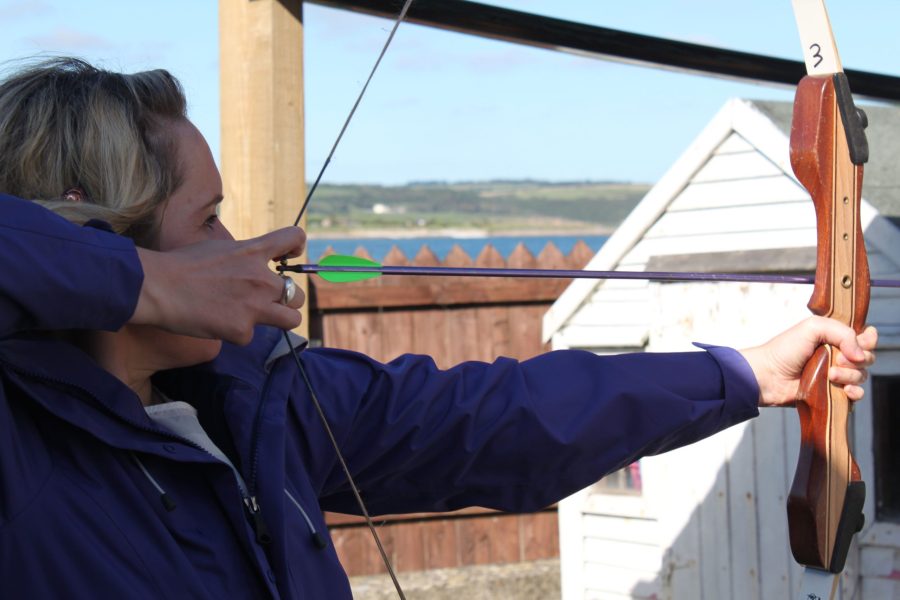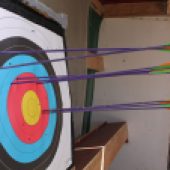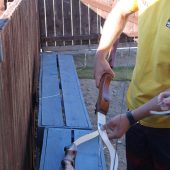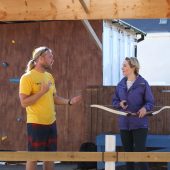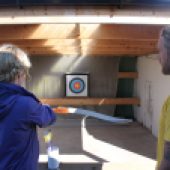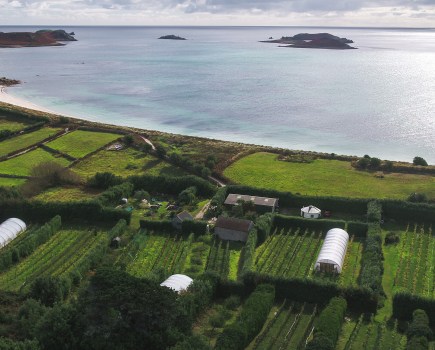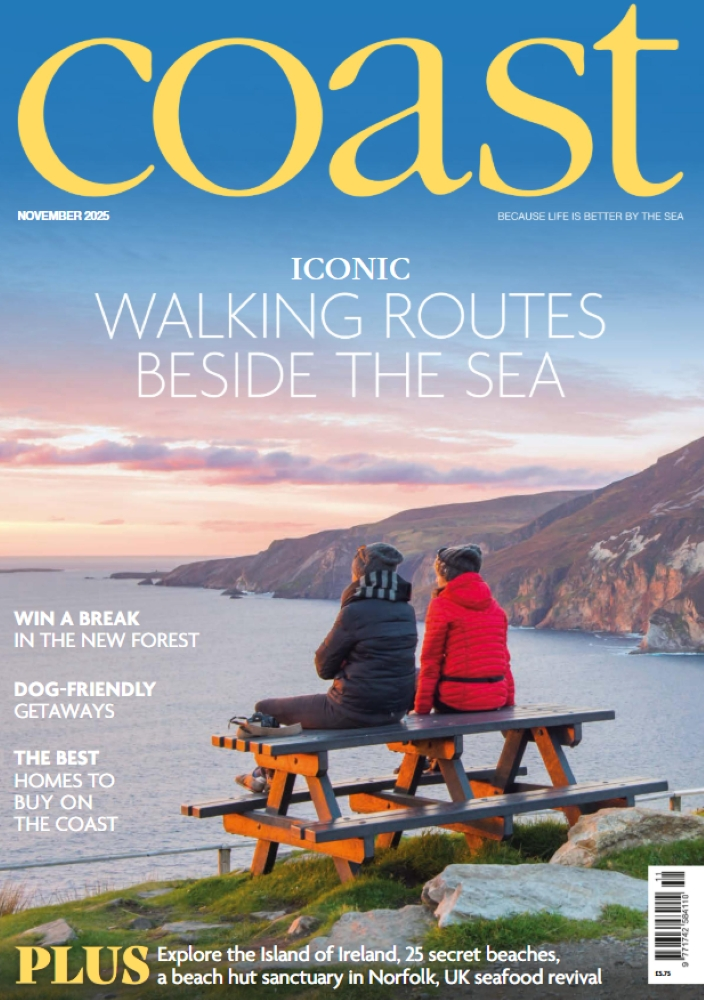Once a deadly weapon for huntsman and those in battle, the draw of the longbow is now appealing to a new generation. Words Jessica Johnson.
The archer’s prowess is the stuff of myth and legend, featuring Viking warriors and gallant heroes of the big screen. Where would Robin Hood or Tolkien’s Legolas be without their trusty longbows?
This ancient sport goes back to the times of the Egyptians, for whom the bow and arrow was a valuable hunting weapon. In England the widespread use of the longbow was introduced following the Battle of Hastings and has long demanded strength, precision and bags of perseverance: in 1363, a Royal decree required all men over the age of seven to spend their Sunday and
Bank Holidays in practice.
Archery’s place in military history was abandoned in the early 1600s in favour of the hand-held firearm. Yet, it still holds its ground as a global sport. There are now archery clubs, societies and tournaments in every corner of the British Isles while the Olympic Games has been bringing some of the world’s most accomplished archers together on an international stage since 1900.
I’m taking my first lesson in archery at Ardmore Adventures, right next to the sparkling waters of Ardmore Bay on Ireland’s south-east coast. My instructor, company founder and manager Ronan O’Connor, has been teaching the sport for 14 years. His nickname amongst his students is Legolas and, by all accounts, he lives up to his reputation.
Starting off
Ronan takes me to a wooden veranda from which I’ll stand, aim and, hopefully shoot at a ring of coloured concentric circles. The bright yellow inner circle yields the highest score of 10, graduating numerically through rings of red, blue and black, out to a wide band of white. Ronan hands me a Re-curve bow that feels smooth and strong. Made from moulded plastic, it is one of the most common bows for beginners because of its lighter limbs – the arched section made of a plywood and fibreglass combination inserted at the front of the bow – and its capacity for storing more energy (for its size) compared to that of the traditional longbow. I take my aluminium arrow with its freshly sharpened point of stainless steel and prepare to load up.
Bows and arrows
This isn’t as easy as ‘ye merry men of old England’ would have us believe. The arrow has three plastic vanes close to the nock (the opposite end to the spear),of which one vane – the bright orange cock fletch – is to face upward when loading the bow. ‘Orange like the sun above us,’ as Ronan instructs the children under his tutelage. This section of fletching helps guide the arrow mid-flight and, for the Native American Indians, was traditionally fashioned from the feathers of hawks and eagles.
Aim and fire
Turning the bow horizontally, I place the arrow into the shelf of the arrow rest, and guide the nock on to the string. With elbows high and shoulders relaxed, I lift the bow vertically and draw back my right arm. Squinting down the length of the arrow and zoning in on the yellow circle, I deliberate for what seems like many minutes on the perfect moment for release. My arm begins to tremble with the effort of keeping such a powerful weapon fully drawn: I lose my aim completely and the arrow flies off, slightly haphazardly, to land in the white perimeter.
Try and try again
Shooting an arrow off through the air has an undeniable feel-good factor attached. I load up another and follow Ronan’s advice to keep both eyes open, which undoubtedly produces better results. I still hit the white, but my second arrow lands surprisingly close to the first. This happens again and again which, according to Ronan, is a sign of progress. ‘Clustering your arrows helps greatly for setting your sights and then adjusting your shots,’ he tells me. It’s not all bad, then.
On target
Now I’m comfortable with basic aiming, we get to work on a few basic posture improvements. I try dropping my shoulders a little and stand vertically instead of leaning back when drawing the bow. Ronan spots my hesitation to draw the bow right back to my face when taking aim. This, he tells me, is a typical affliction of an arching novice.
Tales of old
Arms aching, I take comfort in Ronan’s stories of archery greats. ‘When the longbow was used as a means of staying alive on a ship or from a fixed position, one recurring reality would have been shoulder injuries caused by constant drawing back of the bow,’ he tells me, bow effortlessly poised and ready to shoot. In contrast to tensions of up to 180lbs for the traditional longbows used at battles such as Agincourt, my lightweight bow feels positively feather-like in my grasp.
Speed round
I may not have cracked the yellow, but clusters are my forte – and so comes a challenge. In two minutes I must fire off as many arrows as I can. The number is then halved for my one-minute rating (Ronan’s personal best being 13). This is pressure of a different kind that results in a hurried notching of arrows to bow, and much bending down to retrieve my fallen weapons as the seconds tick by. Speed rounds are a fun way to fine-tune shots. Ronan also favours pinning up scattered balloons and decks of cards that help to improve speed, confidence and accuracy.
Archery for all
As the hour-long lesson comes to a close, all I want to do is carry on shooting to better my scores. A healthy dose of competition is all part of the fun of trying to crack it, whether you’re learning as an individual, a couple or as a large group of friends, according to Ronan. ‘Archery really is for everyone of any age or ability. I’ve yet to meet someone who doesn’t enjoy it and there’s always something people can relate the sport to. Older adults have images of the cowboy and Indian films and teenagers always mention The Hunger Games. It’s not often you get a chance to fire a real weapon that essentially hasn’t changed design in thousands of years.’
And he’s right. With that bow in your hands you grasp the past and present at one and the same vivid moment. It’s a simple yet demanding sport and a dangerously addictive one,
as well. Time for one last arrow.
Need to know
How to get started
Find out more about archery and other outdoor activities in Ardmore and Cork at ardmoreadventures.ie. For details of courses across the British Isles, visit archery.ie and archerygb.org.
Getting there
From either Cork or Waterford airport it’s an hour’s drive to Ardmore on the south-east coast.
What it costs
A one-hour archery lesson starts from £15 per person.
Where to stay
The Cliff House Hotel (00 35324 87800, thecliffhousehotel.com) offers unrivalled views of the Irish Sea. Alongside archery, you can learn to surf, snorkel or kayak in the bay in the light of the moon, with Ardmore Adventures who work closely with the hotel. Room prices start from £180 per room per night with an à la carte breakfast, based on two people sharing.
Ask the Pros
Paralympic archer Mel Clarke has won countless European and World Championship medals representing Great Britain, including a silver medal at the London Paralympic Games 2012.
‘I first tried archery as a Girl Guide leader when I attended a “have a go” session. I wasn’t naturally talented or any good, but I really enjoyed the sport and went with a friend for a ‘beginners’ course’ during the summer holidays. Archery in general is a friendly sport. I have friends all around the world who I compete with (and against!) and it’s great to be able to do a sport together with those athletes. It’s also a sport that pretty much anyone can do – able-bodied, disabled, old, young – and – as I have proven, you don’t need to be any good to start with to achieve success later on. Being able to compete in two Paralympic Games are my greatest achievements. To win a bronze in Beijing in 2008 was fantastic, but to go one better in 2012 and win a silver in London with my family, friends and all the people who have supported me there to see was amazing.’
Once a deadly weapon for huntsman and those in battle, the draw of the longbow is now appealing to a new generation. Words Jessica Johnson.
The archer’s prowess is the stuff of myth and legend, featuring Viking warriors and gallant heroes of the big screen. Where would Robin Hood or Tolkien’s Legolas be without their trusty longbows?
This ancient sport goes back to the times of the Egyptians, for whom the bow and arrow was a valuable hunting weapon. In England the widespread use of the longbow was introduced following the Battle of Hastings and has long demanded strength, precision and bags of perseverance: in 1363, a Royal decree required all men over the age of seven to spend their Sunday and
Bank Holidays in practice.
Archery’s place in military history was abandoned in the early 1600s in favour of the hand-held firearm. Yet, it still holds its ground as a global sport. There are now archery clubs, societies and tournaments in every corner of the British Isles while the Olympic Games has been bringing some of the world’s most accomplished archers together on an international stage since 1900.
I’m taking my first lesson in archery at Ardmore Adventures, right next to the sparkling waters of Ardmore Bay on Ireland’s south-east coast. My instructor, company founder and manager Ronan O’Connor, has been teaching the sport for 14 years. His nickname amongst his students is Legolas and, by all accounts, he lives up to his reputation.
Starting off
Ronan takes me to a wooden veranda from which I’ll stand, aim and, hopefully shoot at a ring of coloured concentric circles. The bright yellow inner circle yields the highest score of 10, graduating numerically through rings of red, blue and black, out to a wide band of white. Ronan hands me a Re-curve bow that feels smooth and strong. Made from moulded plastic, it is one of the most common bows for beginners because of its lighter limbs – the arched section made of a plywood and fibreglass combination inserted at the front of the bow – and its capacity for storing more energy (for its size) compared to that of the traditional longbow. I take my aluminium arrow with its freshly sharpened point of stainless steel and prepare to load up.
Bows and arrows
This isn’t as easy as ‘ye merry men of old England’ would have us believe. The arrow has three plastic vanes close to the nock (the opposite end to the spear),of which one vane – the bright orange cock fletch – is to face upward when loading the bow. ‘Orange like the sun above us,’ as Ronan instructs the children under his tutelage. This section of fletching helps guide the arrow mid-flight and, for the Native American Indians, was traditionally fashioned from the feathers of hawks and eagles.
Aim and fire
Turning the bow horizontally, I place the arrow into the shelf of the arrow rest, and guide the nock on to the string. With elbows high and shoulders relaxed, I lift the bow vertically and draw back my right arm. Squinting down the length of the arrow and zoning in on the yellow circle, I deliberate for what seems like many minutes on the perfect moment for release. My arm begins to tremble with the effort of keeping such a powerful weapon fully drawn: I lose my aim completely and the arrow flies off, slightly haphazardly, to land in the white perimeter.
Try and try again
Shooting an arrow off through the air has an undeniable feel-good factor attached. I load up another and follow Ronan’s advice to keep both eyes open, which undoubtedly produces better results. I still hit the white, but my second arrow lands surprisingly close to the first. This happens again and again which, according to Ronan, is a sign of progress. ‘Clustering your arrows helps greatly for setting your sights and then adjusting your shots,’ he tells me. It’s not all bad, then.
On target
Now I’m comfortable with basic aiming, we get to work on a few basic posture improvements. I try dropping my shoulders a little and stand vertically instead of leaning back when drawing the bow. Ronan spots my hesitation to draw the bow right back to my face when taking aim. This, he tells me, is a typical affliction of an arching novice.
Tales of old
Arms aching, I take comfort in Ronan’s stories of archery greats. ‘When the longbow was used as a means of staying alive on a ship or from a fixed position, one recurring reality would have been shoulder injuries caused by constant drawing back of the bow,’ he tells me, bow effortlessly poised and ready to shoot. In contrast to tensions of up to 180lbs for the traditional longbows used at battles such as Agincourt, my lightweight bow feels positively feather-like in my grasp.
Speed round
I may not have cracked the yellow, but clusters are my forte – and so comes a challenge. In two minutes I must fire off as many arrows as I can. The number is then halved for my one-minute rating (Ronan’s personal best being 13). This is pressure of a different kind that results in a hurried notching of arrows to bow, and much bending down to retrieve my fallen weapons as the seconds tick by. Speed rounds are a fun way to fine-tune shots. Ronan also favours pinning up scattered balloons and decks of cards that help to improve speed, confidence and accuracy.
Archery for all
As the hour-long lesson comes to a close, all I want to do is carry on shooting to better my scores. A healthy dose of competition is all part of the fun of trying to crack it, whether you’re learning as an individual, a couple or as a large group of friends, according to Ronan. ‘Archery really is for everyone of any age or ability. I’ve yet to meet someone who doesn’t enjoy it and there’s always something people can relate the sport to. Older adults have images of the cowboy and Indian films and teenagers always mention The Hunger Games. It’s not often you get a chance to fire a real weapon that essentially hasn’t changed design in thousands of years.’
And he’s right. With that bow in your hands you grasp the past and present at one and the same vivid moment. It’s a simple yet demanding sport and a dangerously addictive one,
as well. Time for one last arrow.
Need to know
How to get started
Find out more about archery and other outdoor activities in Ardmore and Cork at ardmoreadventures.ie. For details of courses across the British Isles, visit archery.ie and archerygb.org.
Getting there
From either Cork or Waterford airport it’s an hour’s drive to Ardmore on the south-east coast.
What it costs
A one-hour archery lesson starts from £15 per person.
Where to stay
The Cliff House Hotel (00 35324 87800, thecliffhousehotel.com) offers unrivalled views of the Irish Sea. Alongside archery, you can learn to surf, snorkel or kayak in the bay in the light of the moon, with Ardmore Adventures who work closely with the hotel. Room prices start from £180 per room per night with an à la carte breakfast, based on two people sharing.
Ask the Pros
Paralympic archer Mel Clarke has won countless European and World Championship medals representing Great Britain, including a silver medal at the London Paralympic Games 2012.
‘I first tried archery as a Girl Guide leader when I attended a “have a go” session. I wasn’t naturally talented or any good, but I really enjoyed the sport and went with a friend for a ‘beginners’ course’ during the summer holidays. Archery in general is a friendly sport. I have friends all around the world who I compete with (and against!) and it’s great to be able to do a sport together with those athletes. It’s also a sport that pretty much anyone can do – able-bodied, disabled, old, young – and – as I have proven, you don’t need to be any good to start with to achieve success later on. Being able to compete in two Paralympic Games are my greatest achievements. To win a bronze in Beijing in 2008 was fantastic, but to go one better in 2012 and win a silver in London with my family, friends and all the people who have supported me there to see was amazing.’

